Absolutely Accurate Relativeness
April 14th, 2021 | by Andreas Richter
(3 min read)
When we are talking about HD maps we often hear that we need high precision and accuracy. And map providers promote their maps with claims such as: “Up to 4 centimeters!“. But what is that telling us and do I really need this?
For talking about high precision and accuracy let’s define terms! To gain accuracy we need precision and trueness:
- Trueness defines if we really hit the goal. If the deviation is getting greater, trueness is getting less.
- Precision defines if we hit the goal multiple times with a small deviation (scatter).
- Accuracy needs trueness and precision. If both is high, we have also a high accuracy.
If you don’t believe this, have a look into the ISO 5725 definition!

In general, we refer to accuracy if we say: “up to 4 centimeters“. Literally, if you print an HD map on a large sheet of paper and put it on the road, it should fit reality with all its elements having a spatial deviation of less than or equal to 4 centimeters.
But a printed map shows only an excerpt of the whole reality and leads to two additional terms we need: absolute and relative accuracy. The elements in a paper map have relative accuracy (to each other) but no absolute accuracy. Here, having no absolute accuracy means that if you put this huge paper some meters next to the originally mapped location its content instantaneously loses its validity. But, if you can really position and align it properly to the origin, the absolute accuracy is high, too. If the sheet of paper is really, really huge, we have to keep in mind that earth is not flat, and, again, we are subject to positional deviation when mapping a 3d world to a 2d medium.
The question is: Do we need absolute accuracy or is relative already sufficient? Well, it depends – as always – on your use case: If you want to use the HD map, for example for automated driving, it makes sense to know for sure where the road marks and curbs are located. 10 centimeter of deviation could already ruin your rims or let you move into the opposite lane. But you don’t really need to know if the overall road in reality is located a little bit northwards or eastwards as long as all elements within the road are in their place. For navigation purpose you only need to know your location roughly (in terms of the dilution of precision the used (satellite) positioning system is providing) to map yourself to the correct road edge. If you are on rails, it is more crucial to know whether you are on the left or on the right track.
If you build a bridge, tunnel or continental railroad starting on both sides, it is very important to also have a high absolute accuracy. If not, you could fail making ends meet…

It is very complex to deal with the absolute accuracy because the world is changing constantly due to continental drift. Japan, for example, moves every year by about 8.3 centimeters. The great Tōhoku earthquake in March 2011 moved Japan’s main Island Honshu incredible 2.4 meters eastwards (and shifted the earth on its rotational axis by almost 10 centimeters)! Which implication would such an earthquake have on maps? Simplified, all mapped data which is absolutely anchored would need an offset applied in order to be “correct” again (but the displacement is way more complex to be honest). Staying in this metaphorical example all maps showing just topographic and infrastructural features of local roads in an isolated large-scale context would not necessarily have to be corrected.
Absolute correctness is derived using fixed points (survey marks) defined all over an area of interest. They are surveyed with high effort (this is another story to tell) and form fulcrums for triangulation to help to create accurate large-scale maps. A fixed point is a ground truth and therefore can be used to reduce measurement deviation for all geographic features.
Now we should know relatively well how absolutely we need precision and that sometimes absolute is relative. And by the way: Germany’s former chancellor Helmut Schmidt explained “relative” in the following way: “Five bottles in the wine cellar are few. Five bottlers in the government are a lot.“